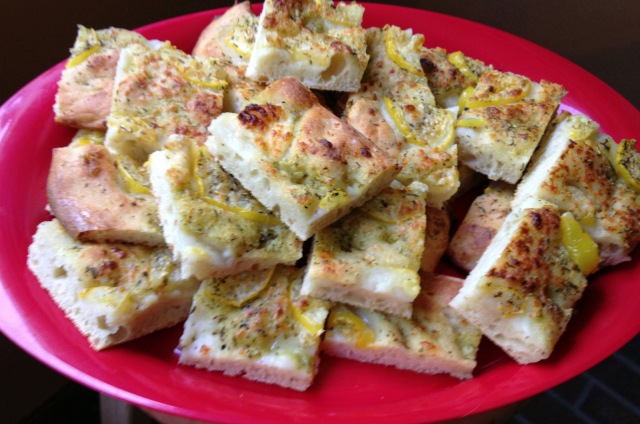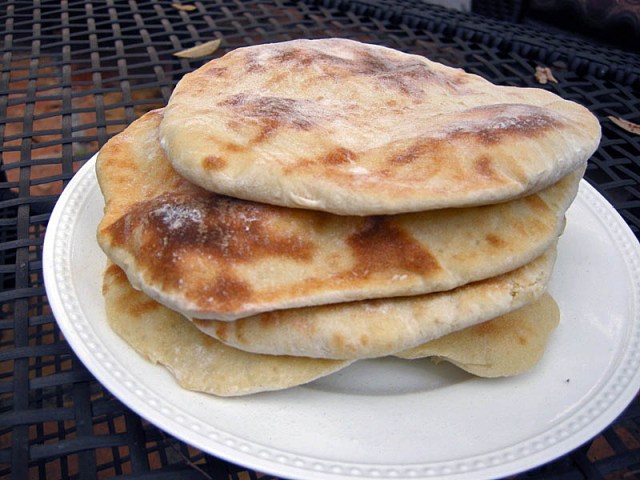A few months ago I followed an interesting discussion at The Fresh Loaf forum, in which a member (Kevin) made a mistake while scaling up a recipe (I can relate to that too well, by the way) and ended up with one of the best focaccias he’d ever made! Being a very experienced baker, he made several batches of the same recipe, to convince himself that the small alteration in the method was indeed responsible for the outcome. It all comes down to holding back some of the water (and the salt) in the recipe, and adding it a little later to the dough. The rationale behind doing it was actually discussed a few years ago by Steve in his blog “Breadcetera” – check it out by clicking here.
I was anxious to try this variation in my favorite, default recipe, and this past weekend I finally had a chance to perform this important experiment.
 DOUBLE-HYDRATION FOCACCIA
DOUBLE-HYDRATION FOCACCIA
(inspired by The Fresh Loaf Forum)
2 cups lukewarm water, divided
2 tsp active dry yeast
4 cups unbleached bread flour
3 tsp salt
2-3 tsp olive oil
2 T chopped fresh rosemary
1 tsp kosher salt
Measure 1 + 1/2 cup of water in a large bowl, sprinkle yeast over water and stir until dissolved. Using a strong wooden spoon mix 2 cups of flour until smooth, about 2 minutes. Add the remaining 2 cups of flour, and knead with your hands (inside the bowl is fine), until the dough forms a very shaggy mass. Cover the bowl with plastic wrap and let it sit at room temperature for 20 minutes.
Dissolve the salt in the remaining 1/2 cup of (lukewarm) water. Add it to the dough, and mix with your hands using a squishing/kneading motion. Do not be alarmed by the look of the dough at this point. Slowly the water and salt will find their way into the mixture. Once it all seems incorporated, cover the bowl and let it rise undisturbed for 1 hour and 20 minutes. The dough will be very bubbly at this point.
Heat the oven to 450F. Lightly oil a 9 x 13 inch baking sheet. Pour the dough onto the sheet, brush the surface with 2 tsp olive oil. Dip your fingers in cold water or olive oil and make indentations all over the dough, working to stretch the dough as you go. Brush the surface with another teaspoon of olive oil, sprinkle with rosemary and salt.
Place in the oven and bake for about 20 minutes, until golden brown. Cool on a wire rack and….
ENJOY!
to print the recipe, click here
Comments: Compared to the regular recipe, this focaccia rose a lot more, had a more airy crumb, and a softer crust. If you like to use focaccia to made a sandwich, a panini-type production, this recipe is perfect for it. However, to make a proper comparison, I must wait until we get home. With a large oven, I will be able to make two batches, bake them at the same time and draw a clear conclusion. So, stay tuned. June is not too far away. (I say that with mixed feelings, it won’t be easy to say goodbye to Los Angeles… )
I am submitting this post to Susan’s Yeastspotting, a must-visit site for all lovers of bread…
and, I am also joining a fun blog party, hosted by Alyssa from Cupcake Apothecary: “A Themed Bakers Sunday.” This week the theme is a favorite of mine: Bread! Check out all the other entries and vote for your favorite!
ONE YEAR AGO: Pierre Nury’s Bougnat (awesome recipe!)






























